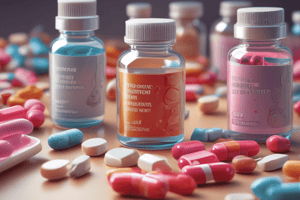Podcast
Questions and Answers
What is the typical trough vancomycin steady-state concentration range recommended for infections with susceptible organisms?
What is the typical trough vancomycin steady-state concentration range recommended for infections with susceptible organisms?
- 15-20 μg/mL
- 10-15 μg/mL (correct)
- 5-10 μg/mL
- 20-25 μg/mL
Why is a higher trough vancomycin concentration range of 15-20 μg/mL recommended in some institutions?
Why is a higher trough vancomycin concentration range of 15-20 μg/mL recommended in some institutions?
- To treat infections with MRSA strains with higher MIC values (correct)
- To ensure adequate vancomycin levels in critically ill patients
- To prevent nephrotoxicity
- To account for poor lung tissue penetration
What is the average serum to tissue ratio for vancomycin penetration in the lungs?
What is the average serum to tissue ratio for vancomycin penetration in the lungs?
- 2:1
- 1:1
- 6:1 (correct)
- 4:1
What is the relationship between higher trough vancomycin concentrations and nephrotoxicity?
What is the relationship between higher trough vancomycin concentrations and nephrotoxicity?
How does vancomycin-induced nephrotoxicity typically compare to aminoglycoside-induced nephrotoxicity?
How does vancomycin-induced nephrotoxicity typically compare to aminoglycoside-induced nephrotoxicity?
What is the typical outcome of vancomycin-induced nephrotoxicity if the antibiotic is withdrawn or doses adjusted?
What is the typical outcome of vancomycin-induced nephrotoxicity if the antibiotic is withdrawn or doses adjusted?
What other potential causes of renal dysfunction should be considered in critically ill patients receiving vancomycin?
What other potential causes of renal dysfunction should be considered in critically ill patients receiving vancomycin?
What is the typical recommendation for vancomycin trough concentrations in the treatment of hospital-acquired pneumonia?
What is the typical recommendation for vancomycin trough concentrations in the treatment of hospital-acquired pneumonia?
Which statement about vancomycin is NOT true?
Which statement about vancomycin is NOT true?
What is the primary mechanism of action of vancomycin?
What is the primary mechanism of action of vancomycin?
Which of the following statements accurately describes the pharmacokinetics of vancomycin?
Which of the following statements accurately describes the pharmacokinetics of vancomycin?
What is the primary reason for using vancomycin in clinical practice?
What is the primary reason for using vancomycin in clinical practice?
What is the recommended ratio of vancomycin concentration to the minimum inhibitory concentration (MIC) for effective bacterial killing?
What is the recommended ratio of vancomycin concentration to the minimum inhibitory concentration (MIC) for effective bacterial killing?
Which of the following statements accurately describes the bacterial spectrum of vancomycin?
Which of the following statements accurately describes the bacterial spectrum of vancomycin?
Which of the following patient populations is most likely to receive vancomycin therapy?
Which of the following patient populations is most likely to receive vancomycin therapy?
What is the primary advantage of using vancomycin over other antibiotics for the treatment of resistant gram-positive infections?
What is the primary advantage of using vancomycin over other antibiotics for the treatment of resistant gram-positive infections?
What may be the only result of vancomycin nephrotoxicity with adequate patient monitoring?
What may be the only result of vancomycin nephrotoxicity with adequate patient monitoring?
Which of the following is NOT mentioned as an indicator of a favorable response to antibiotic treatment?
Which of the following is NOT mentioned as an indicator of a favorable response to antibiotic treatment?
When should vancomycin steady-state serum concentrations be measured, according to the text?
When should vancomycin steady-state serum concentrations be measured, according to the text?
What is the reasoning behind measuring only a steady-state trough concentration for vancomycin?
What is the reasoning behind measuring only a steady-state trough concentration for vancomycin?
When is a good time to assess the clinical efficacy of vancomycin treatment, according to the text?
When is a good time to assess the clinical efficacy of vancomycin treatment, according to the text?
What should be consulted regularly to note changes in resistance patterns and minimum inhibitory concentrations for pathogens?
What should be consulted regularly to note changes in resistance patterns and minimum inhibitory concentrations for pathogens?
What is the primary factor that determines the antibiotic therapy prescribed for a patient, according to the text?
What is the primary factor that determines the antibiotic therapy prescribed for a patient, according to the text?
What is the term used in the text to refer to a plot of body temperature over time?
What is the term used in the text to refer to a plot of body temperature over time?
To avoid ototoxicity while receiving vancomycin, clinicians should measure:
To avoid ototoxicity while receiving vancomycin, clinicians should measure:
Which parameter is primarily responsible for the elimination of vancomycin from the body?
Which parameter is primarily responsible for the elimination of vancomycin from the body?
What can happen if vancomycin peak concentration exceeds 40 μg/mL?
What can happen if vancomycin peak concentration exceeds 40 μg/mL?
Which route of vancomycin administration is typically avoided due to the risk of tissue necrosis?
Which route of vancomycin administration is typically avoided due to the risk of tissue necrosis?
In which situation should clinicians assess renal and auditory/vestibular function daily?
In which situation should clinicians assess renal and auditory/vestibular function daily?
What percentage of vancomycin elimination occurs through glomerular filtration?
What percentage of vancomycin elimination occurs through glomerular filtration?
What symptoms can be caused by vancomycin in terms of allergic reactions?
What symptoms can be caused by vancomycin in terms of allergic reactions?
(True/False) Oral bioavailability of vancomycin is high.
(True/False) Oral bioavailability of vancomycin is high.
What is the recommended infusion time for vancomycin to avoid infusion-related side effects?
What is the recommended infusion time for vancomycin to avoid infusion-related side effects?
What is the therapeutic range for steady-state peak vancomycin concentrations?
What is the therapeutic range for steady-state peak vancomycin concentrations?
Why may direct administration of vancomycin into the cerebral spinal fluid be necessary?
Why may direct administration of vancomycin into the cerebral spinal fluid be necessary?
What is the consequence if ototoxicity caused by vancomycin is not addressed with appropriate dosing changes?
What is the consequence if ototoxicity caused by vancomycin is not addressed with appropriate dosing changes?
Why are trough concentrations (pre-dose or minimum concentrations) usually related to therapeutic outcome for vancomycin?
Why are trough concentrations (pre-dose or minimum concentrations) usually related to therapeutic outcome for vancomycin?
What is the optimal bactericidal effect for vancomycin?
What is the optimal bactericidal effect for vancomycin?
Which of the following infusion-related side effects of vancomycin can be largely avoided with a longer infusion time?
Which of the following infusion-related side effects of vancomycin can be largely avoided with a longer infusion time?
What is the primary reason for the potential need to administer vancomycin directly into the cerebral spinal fluid?
What is the primary reason for the potential need to administer vancomycin directly into the cerebral spinal fluid?




